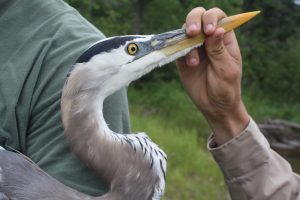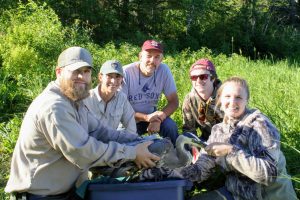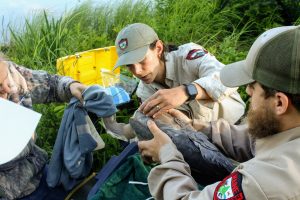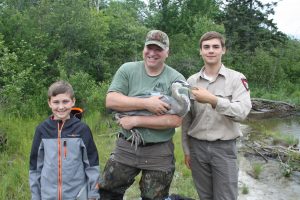July 3, 2018 at 3:21 pm
Snipe, a great blue heron captured in Orrington, was named by the middle school students at Center Drive School.
Two years after five of Maine’s great blue herons were outfitted with high-tech GPS transmitters, IFW once again worked closely with teachers and students from Nokomis Regional High School in Newport, Center Drive School in Orrington, and Haworth Academic Center in Bangor to re-deploy two of the tags on new herons. Starting in May, minnow traps were deployed for catching bait fish to stock bait bins for herons to feed from. For several weeks, a team of biologists, teachers, students, and other volunteers spent time every day baiting the bins and monitoring game cams. Once a heron was lured to a bait bin and found to habitually feed from it, the team set out to capture a heron for tagging. On June 21st, Nokomis Regional High School teacher, Bill Freudenberger and one of his students, Beau Briggs, joined IFW biologists at 3:15 am to set traps and wait in a blind for a non-suspecting heron to get caught as it tried to feed from the bait bin at dawn. Less than three hours later, they had a heron in hand. And within an hour, that heron, now named Warrior by the students after their high school mascot, became the 6th heron in Maine to be tagged with a GPS transmitter.
The capture crew with tagged great blue heron, Warrior. Pictured from left to right: Carl Tugend, IFW volunteer; Danelle D'Auria, IFW biologist; Bill Freudenberger, Nokomis Regional High School teacher; Beau Briggs, Nokomis Regional High School student; and Brittany Currier, IFW contractor.
Warrior is the second tagged heron adopted by Nokomis Regional High School. The first was Nokomis, a female who we now know winters in Haiti. We do not yet know if Warrior is a male or female, but we sent a blood sample to a lab for determination. To date, we have not received any movement data from Warrior’s transmitter, probably due to poor cell coverage in its home area, so we do not yet know if that heron is nesting and where. Click here to watch a video of Warrior’s release. Two days later on June 23rd, biologists set out to capture a heron in Orrington. While there had been several herons feeding from the bait bin there, biologists had been “skunked” on three prior trapping attempts in early June. However, within only a few minutes of climbing into the blind, a great blue heron was captured in a trap. While no teachers were available that day, two students from Center Drive School’s Heron Club witnessed the measuring, tagging, and release of Snipe, named by the students after the bird character in the movie, Up. Snipe appears to be nesting in a colony in Brewer that hosted two of our other tagged herons, Sedgey and Snark, both males who unfortunately died within the last year. The GPS transmitters from German company, e-obs, were purchased with funds from the Maine Outdoor Heritage Fund in 2016. They are solar-powered and designed to last several years. The two tags that were deployed this spring had been used in 2016 to track Sedgey and Snark. When they had died, the transmitters were recovered so they could be used again. When fully charged, they record a GPS location as often as every five minutes. Once a day at around 6 pm, the transmitters connect via cell towers to download the GPS location data to www.movebank.org, where anyone can view and download the data for use in programs such as Google Earth, ArcMap, or Microsoft Excel. Two herons tagged in 2016, Cornelia and Nokomis, are still alive and their transmitters are still functional and providing data via the Movebank website.
IFW biologists ensure the perfect fit for Warrior's transmitter.
This project has provided a better understanding of habits and movements of Maine’s great blue herons, a state Species of Special Concern due to a decline in nesting pairs along the coast. The data provided by the transmitters can shed light on daily and seasonal movements, energy budgets, nesting and feeding habitat requirements, survival and adult mortality, territory and home range sizes, the role predation and disturbance play in limiting nesting success, colony fidelity (whether a bird returns to the same colony year after year), migration routes, and wintering locations. In the first two years of this study, we have documented wintering sites in Florida, the Bahamas, Cuba, and Haiti; a heron who switched its nesting colony; variability in timing (initiation date and duration) of migration among individuals; and seasonal changes in foraging habitat use. The other main objective of the Heron Tracking Project is to connect students of all ages to the tagged herons and the places they nest, feed, and winter. Students are involved with the field work leading up to the tagging of each bird, and then they follow them online, using the data to answer their own questions about the herons’ lives. Our tagged herons have been the subjects of student research projects for fifth graders at Harpswell Community School, high school students for the Maine State Science Fair, a Wetlands Ecology and Conservation class at University of Maine, and Wildlife Capstone Projects at Unity College. There are endless opportunities for learning from the data, thus we hope to get even more students involved.
Just before Snipe is released. Pictured from left to right: Andrew Faulkingham, Center Drive School student; Chip McKnight, IFW volunteer; and Colby Slezak, IFW intern.
For more information on the Heron Tracking Project, and how to view or download the data, please click here.



